CBSE Delhi-Set-1-2004
To Access the full content, Please Purchase
-
Q1
In the diagram below is shown a circular loop carrying crurent I. Show the direction of the magnetic field with the help of lines of force.
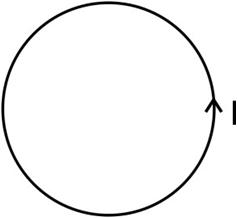 Marks:1View Answer
Marks:1View AnswerAnswer:
The direction of magnetic field is shown in figure below,
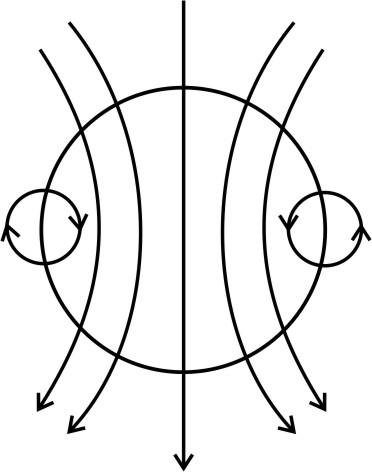
-
Q2
Name the type of modulation scheme preferred for digital communication. Marks:1View AnswerAnswer:
The type of modulation scheme preferred for digital communication is pulse code modulation (PCM). -
Q3
Write the nuclear decay process for  Marks:1View Answer
Marks:1View AnswerAnswer:
The required equation is given below:

-
Q4
What is the name given to that part of electromagnetic spectrum which is used for taking photographs of earth under foggy conditions from great heights? Marks:1View AnswerAnswer:
Infrared rays. -
Q5
‘Heavy water is often used as a moderator in thermal nuclear reactors.’ Give reason. Marks:1View AnswerAnswer:
The mass of heavy water is nearest to that of a neutron. This minimizes the chances of neutron absorption by heavy water. This is the reason for which we use it as moderator. -
Q6
Explain with the help of diagram the terms (i) magnetic declination and (ii) angle of dip at a given place. Marks:2View AnswerAnswer:
(i) Magnetic declination: The angle between the geometric meridian and magnetic meridian at a given place is called magnetic declination at that place. It is denoted by symbol(  ).
).

(ii) Angle of dip: It is the angle made by the earth’s total magnetic field with the horizontal at a given place. It is denoted by symbol (  ).
). -
Q7
Find the wavelength of electromagnetic waves of frequency 5 x 1019Hz in free space. Give its two applications. Marks:2View AnswerAnswer:
The wavelength for the given frequency is given by the relation,
 = c/v
= c/v
= (3 108)/(5
108)/(5 1019)
1019)
=( 6 10-12)m
10-12)m
= 0.006 Ao
This wavelength of light falls into X-rays region, which can be used for, (i) The treatment of certain diseases. (ii) Diagnosis of diseases. -
Q8
A compound microscope with an objective of 1.0 cm focal length and an eye-piece of 2.0 cm focal length has a tube length of 20 cm. Calculate the magnifying power of the microscope, if the final image is formed at the near point of the eye. Marks:2View AnswerAnswer:
We have the relation,
m = mo me = (L/fo) x (D/fe) Here, L=20 cm, fo=1 cm, fe=2 cm.  m = (20 / 1) x (25 / 2) = 250
m = (20 / 1) x (25 / 2) = 250 -
Q9
Draw the graph showing the variation of binding energy per nucleon with mass number. Give reason for the decrease of binding energy per nucleon for nuclei with high mass numbers.
Marks:2View AnswerAnswer:
The graph showing the variation of binding energy per nucleon with mass number of different atomic nuclei is given below,
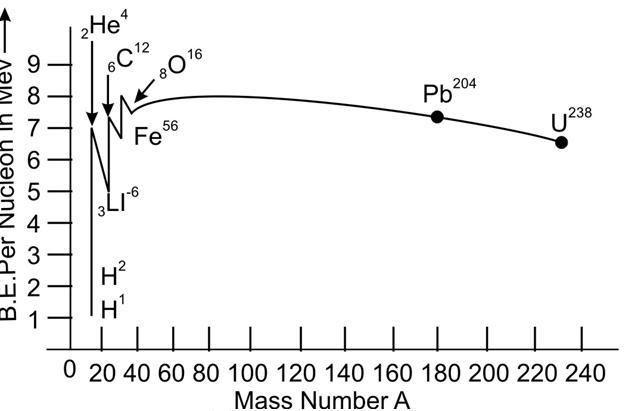
The binding energy per nucleon for nuclei with high mass numbers is low because there is large coulomb replusion between the protons inside the nuclei. -
Q10
The graph shows the variation of voltage, ‘V’ across the plates of two capacitors A and B versus increase of charge, ‘Q’ stored on them. Which of the two capacitors has higher capacitance? Give reason for your answer.
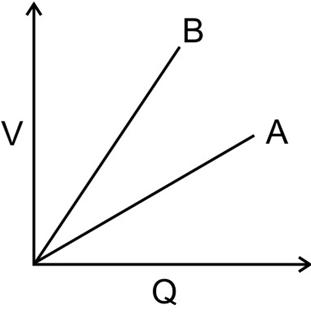 Marks:2View Answer
Marks:2View AnswerAnswer:
First of all consider the figure below,
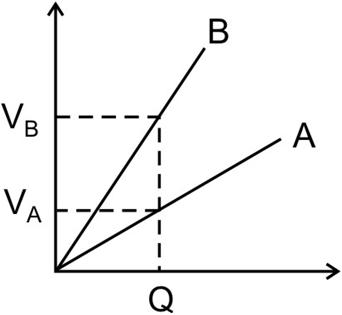
Now we have the relation, Q=CV.
or C = Q/V. For capacitor A we can write, CA = Q/VA Similarly for capacitor B we can write, CB = Q/VB. Here since VA < VB.  CA >CB
CA >CB



